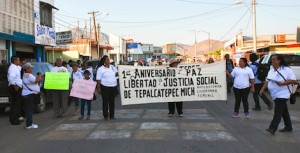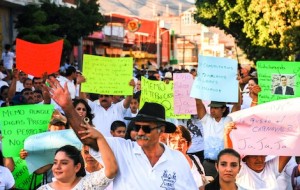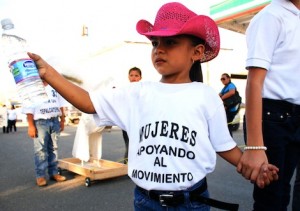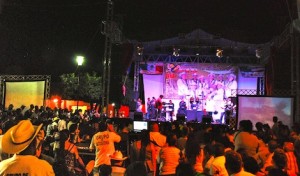 On Feb. 24, 2013, residents of La Ruana and Buenavista Tomatlán in Michoacan took up arms and declared war on the Knights Templar. The “Templarios” had grasped control of the region’s economic and political structures, terrorizing the public with violence, rape, abductions and land grabs.
On Feb. 24, 2013, residents of La Ruana and Buenavista Tomatlán in Michoacan took up arms and declared war on the Knights Templar. The “Templarios” had grasped control of the region’s economic and political structures, terrorizing the public with violence, rape, abductions and land grabs.
The self-defense groups were established by local farmers and ranchers and emerged when it became clear the Mexican government was incapable of attacking the drug traffickers and their increasingly violent criminal activity. Although Mexico has received more than $1 billion from the U.S. government as part of the Merida Initiative security aid package, violence in Mexico has claimed more than 80,000 victims over the past 12 years. Because of this, Mexican Bishop Raul Vera referred to the Michoacan uprising and called the U.S.-funded war on drugs, a “mere fiction”.
“When we started our struggle, we knew the state government was our No. 1 enemy,” Jose Manuel Mireles, a doctor from the nieghboring municipality of Tepalcatepec, told the Americas Program. In January, Mireles – the self defense groups’ spokesman since the outset – was badly injured when the small plane in which he was traveling made a crash landing and taken to Mexico City to recover.
 Now back home again, Mireles boasts of the groups’ achievements. The movement has pushed the “Templarios” out of more than 30 municipalities, he claims, and aims to free the entire state of Michoacan from the presence of the criminal group. “In the past year, we have learned a great deal,” Mireles said. “Most importantly, we learned that we have a weapon more powerful than the cartel’s guns – a community.”
Now back home again, Mireles boasts of the groups’ achievements. The movement has pushed the “Templarios” out of more than 30 municipalities, he claims, and aims to free the entire state of Michoacan from the presence of the criminal group. “In the past year, we have learned a great deal,” Mireles said. “Most importantly, we learned that we have a weapon more powerful than the cartel’s guns – a community.”
La Ruana and Tepalcatepec are picturesque villages. It’s hard to imagine their people have endured so many atrocities. On Feb. 24, residents prepared to celebrate the one-year anniversary of the uprising. Mariachis, barbecue and beer had been brought in for the big party. A parade with hundreds of people wearing t-shirts that read “Self-Defense Groups for a Free Tepalcatepec” kicked off the activities.
“A year ago Tepalcatepec was a living hell, a ghost town where you couldn’t even walk around,” Mireles observed. “This is a great achievement because they said our movement wouldn’t last 24 hours, yet here we are today.” Mireles left the hospital two weeks ahead of schedule to be back home to celebrate with his people.
Early last year, the government sought to take control of the situation by disarming the self-defense groups, inciting unrest that resulted in several arrests and a fatality and nearly prompted a major confrontation between the self defense groups and the Army. The official strategy shifted and the government made a pact with some of the self-defense groups. They agreed to register all weapons and legalize some members of the self-defense groups.
However, there were critics, including Buenavista native Luis Antonio Torres Gonzales, aka “El Americano”. “The government is trying to establish us as rural police troops, but we rejected being placed under the government’s authority. We refuse to stand around and let people continue to get killed,” said “El Americano.”
The government stratgy involves keeping a presence of Army and Federal Police troops while engaging in negotiations with individual self-defense leaders. The federal government recently promised an injection of 45 billion pesos for development projects in Michoacan.
 Hipolito Mora, another self-defense group leader, sees the government funds as a positive step. “We’re hoping to take advantage of the government support to revive the economy,” Mora explained. “The dream we’re now embracing is to generate sources of employment.” He believes the government should work alongside the self-defense groups, because the locals are the ones who can identify the criminals in each village. Mora denied rumors of division within the organization, but admitted there are differences. He says the priority should be to strengthen the self-defense groups, suggesting that the government and the public working together can rid them of infiltrators.
Hipolito Mora, another self-defense group leader, sees the government funds as a positive step. “We’re hoping to take advantage of the government support to revive the economy,” Mora explained. “The dream we’re now embracing is to generate sources of employment.” He believes the government should work alongside the self-defense groups, because the locals are the ones who can identify the criminals in each village. Mora denied rumors of division within the organization, but admitted there are differences. He says the priority should be to strengthen the self-defense groups, suggesting that the government and the public working together can rid them of infiltrators.
Both Mora and Mireles were asked if they would accept a government post if it were offered. “I would accept such an offer only if it benefits the public, not for my own personal benefit,” Mora declared. Mireles gave a different answer. “I am solely focused on the movement. I fear that if the movement is politicized, it will be over because towns can be divided by political parties.” Now recovered from his injuries, Mireles has resumed his role as a spokeman, promising to continue to help other municipalities.
Mireles says the movement was inspired by the autonomous indigenous town of Cheran, which kicked out illegal loggers and political parties, setting up its own patrols to defend its territory and to prevent organized crime activity. The Cheran movement based its autonomy on Convention No. 169 of the International Labor Organization and the U.N. Declaration on the Rights of Indigenous Peoples. He notes that these rights don’t apply in the same way to his movement, comprised of mestizos, but they serve as a model.
Mireles asserts that the self-defense movement bases its legitimacy on Article 10 of the Mexican Constitution: “Every Mexican citizen has the right to have a gun in their home, for security and self-defense” and Article 39, which states “national sovereignty resides essentially and originally in the people … Citizens have at all times the inalienable right to alter or modify their form of government.” The spokesperson explains that the self-defense groups were originally called “communitarians” as are many of the indigenous groups, but they adopted the name self-defense groups since self defense is a legal right of all Mexicans. He notes that the groups “made a pact so that when elections come, they will not divide us.”
Two days after the anniversary festivities, the self-defense groups advanced toward the four corners of Michoacan, taking control of Santa Clara del Cobre, Opopeo and Zirahuén. Their goal was to continue to the state capital of Morelia, but the newly appointed federal commissioner ordered the Federal Police to stop their advance.
 In Buenavista and other communities, the self defense groups have turned their attention to rebuilding the community after ousting the criminal gangs. In new neighborhood councils, representatives propose initiatives and deliver petitions to the government or consult on what measures to take. Some people worry about their children, who have been growing up in q ar environment where they learn about different calibers of weapons, see murders close up and are close to many forms of violence. Others struggle to cope after losing children, siblings or parents, and still others have loved ones imprisoned for taking up arms.
In Buenavista and other communities, the self defense groups have turned their attention to rebuilding the community after ousting the criminal gangs. In new neighborhood councils, representatives propose initiatives and deliver petitions to the government or consult on what measures to take. Some people worry about their children, who have been growing up in q ar environment where they learn about different calibers of weapons, see murders close up and are close to many forms of violence. Others struggle to cope after losing children, siblings or parents, and still others have loved ones imprisoned for taking up arms.
None of that dampened spirits at the anniversary festivities though. Michoacan’s self-defense groups celebrated and vowed to continue in arms until the Knights Templar have been defeated.
Santiago Navarro F. is an independent photojournalist and a regular contributor to the Americas Program https://www.americas.org/



